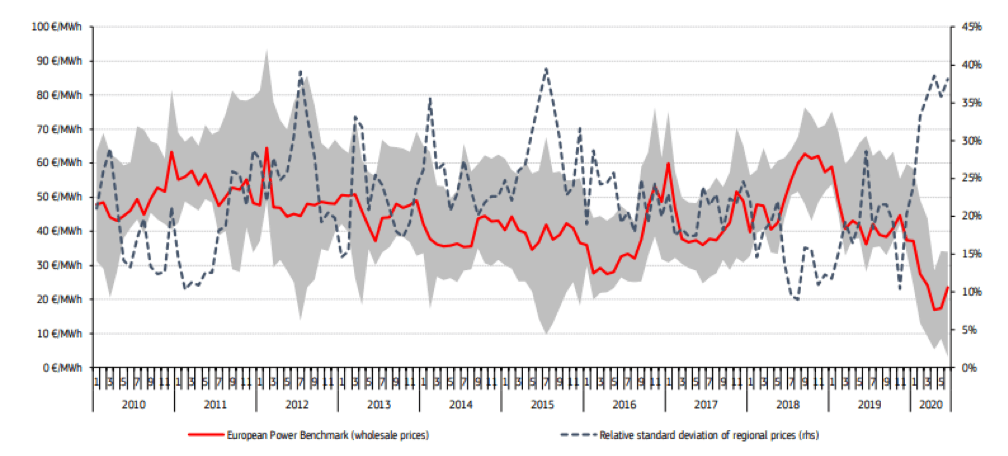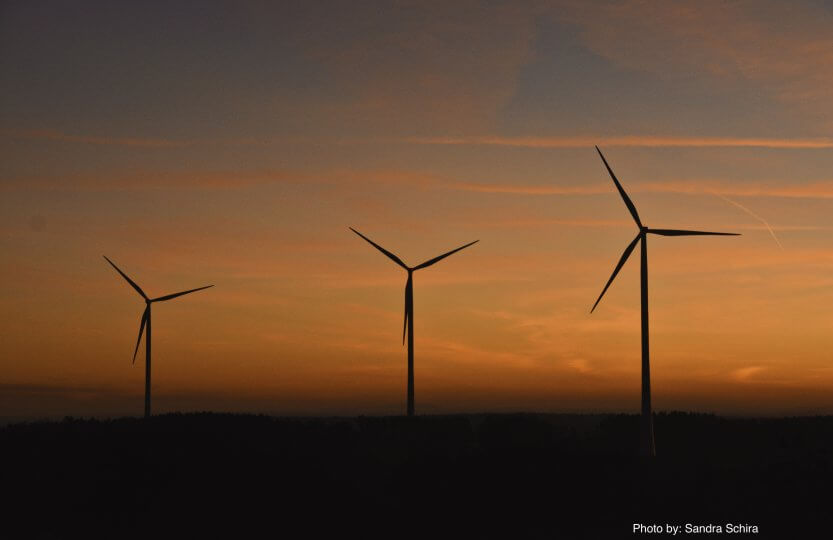Shortly after the appearance of the novel Covid-19 virus in the European Union (EU) in January 2020, governments enacted national lockdowns as containment measures (ECDC 2020). Since these measures included a shutdown of many major industrial activities, almost all EU member states consequently saw a significant decline in energy demand during spring 2020. Accordingly, electricity prices decreased rapidly and were even temporarily negative (European Commission 2020a). Furthermore, the reduced global economic activity and lockdowns also lead to reduced transport and mobility. Thus, the value of fossil fuels, such as gas and crude oil, declined globally too (European Commission 2020a). Using the example of the European Union, we evaluate why fossil-fuel-based energy production becomes less profitable and how renewable energy production could become the major energy resource in the EU. In doing so, we hypothesize that the current Covid-19 crisis has revealed the already present financial losses that energy producers suffered from and that the crisis could accelerate the transition to a more renewable-focused energy production within the EU.
It was observed that lockdown measures resulted in variations in electricity consumption, composition, profile, distribution as well as the load pattern of the electricity grid (Zhong et al., 2020). To understand these impacts, we can look to Italy and Sweden as contrasting examples. Italy was one of the EU countries that put in place strict national lockdown measures, while Sweden relied instead on voluntary compliance with governmental recommendations (Mondino et al., 2020). Correspondingly, electricity consumption in Italy dropped by 17.7% in the second week of April (compared to the same week in 2019), while no reduction trend was observed during this time in Sweden’s case (Bahmanyar et al., 2020).
We see a change of electricity load composition as well: International Energy Agency (IEA) estimates that in various EU countries, the residential load increased by 40% between the last week of March and first week of April, while the demand of services sector decreased by up to 75%. The total demand for every month of full lockdown reduced by 20% on average (IEA, 2020b). The demand for coal in the EU fell by a historic 20% during the first quarter of 2020 (IEA 2020a). This decline in energy requirements created the need for traditional fossil fuel plants to ramp down their production (Ghiani et al. 2020). These circumstances all led to inevitable price drops. These drops hit the European electricity markets strongly, with monthly average prices during April being at their lowest level in the last six years (AleaSoft, 2020).

So, where does this leave us?
At this point, it is important to remember that within the frame of its climate mitigation commitments the EU established market-based instruments to price greenhouse gas (GHG) emissions. Here, we would like to take a closer look at the European Emission Trading System (EU ETS). The energy producing sector of the EU is obliged to participate in the EU ETS and buy carbon allowances to offset its GHG emissions (European Commission 2021). During the last decade, power plant operators and the EU have heavily invested in modernizing conventional power plants in order to reduce GHG emissions and spending less money on required carbon allowances. This new technology also allows a more flexible energy management of the electricity grid in the plants nowadays (EU Commission 2020b). However, even such modern power plants cannot prevent the emission of Carbon Dioxide (CO2) and other GHGs when coal and other fossil fuels are burned. Hence, in spring 2020, the EU energy sector was on the one hand facing immense costs for paying the relatively stable priced carbon allowances and for managing the novel energy demand flexibly. On the other hand, the EU energy sector suffered from serious losses due to significantly decreased energy prices (European Commission 2020a, Gerlagh et al. 2020, Ghiani et al. 2020). Therefore, the EU energy sector struggled to stay profitable in spring 2020. Here it is important to mention that the price of carbon allowances within the EU could decrease substantially, if economic uncertainty due to Covid-19 prevailed (Gerlagh et. al. 2020).
And how did renewable energies cope during this time?
Despite a global drop in energy demand the renewable energy sector has so far withstood the Covid-19 crisis better than any other energy sector. This can be seen for example on the stock market, where the renewable sector, despite an initial drop in stock prices, rebounded and have since reached all-time highs, while the fossil fuel industry shares fell and failed to recover as well as the renewables (IEA, 2020b). On an EU-level, the pandemic caused a dramatic decrease in energy demand and supply, resulting in an accompanying sharp decline of both CO2 emissions. In total, the EU energy demand for 2020 was expected to be 10% lower than in 2019, which in comparison is double the decrease of that following the 2008 financial crisis. As a result of the decline in the output from especially gas and nuclear sources, renewables reached an all-time high for their relative share in the energy sector. Despite this however, as of now, the EU is not on track for reaching its goals of an increase in the share of renewables in the energy sector to 32% in 2030, nor energy efficiency savings of 32.5% in the same timeframe. In order to reach its goals, major systematic changes are required, together with an acceleration of the implementation of current policies and regulations (IEA 2020a).
However, the possibility of a rebound of fossil fuels, like the one following the 2008 financial crisis, remains. This partly because of low commodity costs globally, but also because investments in renewables were predicted to decline by a third in 2020 compared to that of 2019-levels (IEA, 2020b). It is difficult to predict upcoming trends in renewable energy production in the context of current uncertain times; for example, several predictions from the first quarter of 2020 underestimated the resilience of renewables in their forecasts, with some predicting major decreases in the renewable energy production (IEA, 2020b). It is also important to note that this resilience and increase of renewables only reflects the electricity production sector, which only accounts for about a fifth of the global energy use. For example, since the start of the pandemic the transport sector energy output from renewables dropped by almost 12% (IEA, 2020b).
Nevertheless, the use of renewable energy resources in the energy mix comes with its own challenges, particularly during the Covid-19 pandemic. Constantly changing measures and overall instability made it harder to generate accurate forecasts for requirements of the power system and lockdowns led to a reshaped daily load profile. In combination with the overall drop in energy consumption, the difference between times of peak demand (early mornings and evenings) and times of low demand (afternoons) increased by 5% (Ding et al., 2020). This is important because renewable energy sources such as solar photovoltaic (PV) panels are variable – their energy production fully depends on the availability of sunlight. Consequently, the enacted lockdown measures created a mismatch of timing with sunlight hours and demand hours. This can lead to both overproduction and waste of energy produced by PVs. In this way, the outbreak of COVID-19 reinforces the long-perceived need for flexible responses in the renewable energy industry, especially relating to energy storage. Another challenge brought about by the combination of reshaped demand patterns and increased penetration of variable renewable sources is the voltage rise issue. It is the result of dropping energy demand during the pandemic happening while the generation of power from for example rooftop PVs stays the same. One more apparent difficulty during the pandemic is disruption in scheduled maintenance activities of the grid and generators. Perhaps one of the positive outcomes is that the pandemic shed light on some of the new techniques on management and operation of power systems (Zhong et al., 2020). In conclusion, we are cautiously optimistic that the phase out of fossil-fuel based energy within the EU is not purely dependent on the decisions of local governments but will also be the result of economic decisions. A working emission trading cap with an effective extent, as the EU ETS has, seems to be a successful tool for burdening industries if they do not manage to reduce their GHG emission footprint. Regarding renewable energies, the EU Commission is optimistic that the last year (2020) held positive developments for this energy sector. Furthermore, expectations are that the market share of renewable energies in the EU will increase and that their production costs will decrease because of economies of scale (European Commission 2020a). Yet, disadvantages such as lacking energy storage opportunities prevail (Ghiani et al. 2020). Ultimately, we must not forget that even though the EU puts effort in neutralizing their emissions, its industry is still dependent on huge amounts of fossil fuels imported from abroad (eurostat 2020). Thus, we highlight the need for global cooperation for a common transition to a more sustainable energy production.
References
AleaSoft (2020). Historical fall in demand and prices of the European electricity markets in April. Retrieved, on 31.01.2021, from https://aleasoft.com/historical-fall-demand-prices-european-electricity-markets-april/
Bahmanyar, A., Estebsari, A., & Ernst, D. (2020). The impact of different COVID-19 containment measures on electricity consumption in Europe. Energy Research & Social Sciences 68: 101683
Ding, T., Zhou, Q., & Shahidehpour, M. (2020). Impact of COVID-19 on Power System Operation Planning. [Online]. Retrieved, on 31.01.2021, from https:// smartgrid.ieee.org/newsletters/may-2020/impact-of-covid-19-on-powersystem-operation-planning
European Centre for Disease Prevention and Control (ECDC) (2020). Timeline of ECDC’s response to COVID-19. Retrieved, on 31.01.2021, from https://www.ecdc.europa.eu/en/covid-19/timeline-ecdc-response
European Commission (2020a). Report from the commission to the European Parliament, the Council, the European Economic and Social Committee and the Committee of the Regions – Energy prices and costs in Europe. Retrieved, on 31.01.2021, from https://ec.europa.eu/energy/data-analysis/energy-prices-and-costs_en#documents
European Commission (2020b). Kick-starting the journey towards a climate-neutral Europe by 2050 – EU Climate Action Progress Report. p. 18.
European Commission (2021). EU Emission Trading System. Retrieved, on 31.01.2021, from https://ec.europa.eu/clima/policies/ets_en
Eurostat. (2020). Energy production and imports. Retrieved, on 31.01.2021, from ec.europa.eu/eurostat
Gerlagh, R., Heijmans, R. J. R. K., & Rosendahl, K. E. (2020). COVID-19 tests the Market Stability Reserve. Environmental and Resource Economics 76: 855-865.
Ghiani, E., Galici, M., Mureddu, M., & Pilo, F. (2020). Impact on electricity consumption and market pricing of energy and ancillary services during pandemic of COVID-19 in Italy. Energies 13:3557.
IEA (2020a). European Union 2020, Energy Policy Review, IEA. Retrieved, on 31.01.2021, from https://www.iea.org/reports/european-union-2020
IEA (2020b). Global Energy Review 2020, IEA, Paris. Retrieved, on 31.01.2021, from https://www.iea.org/reports/global-energy-review-2020
Mondino, E., Di Baldassarre, G., Mård, J., Ridolfi, E., & Rusca, M. (2020). Public perceptions of multiple risks during the COVID-19 pandemic in Italy and Sweden. Scientific Data 7: 1–7.
Zhong, H., Tan, Z., He, Y., Xie, L., & Kang, C. (2020). Implications of COVID-19 for the electricity industry: A comprehensive review. CSEE Journal of Power and Energy Systems 6: 489–495.













nice topic